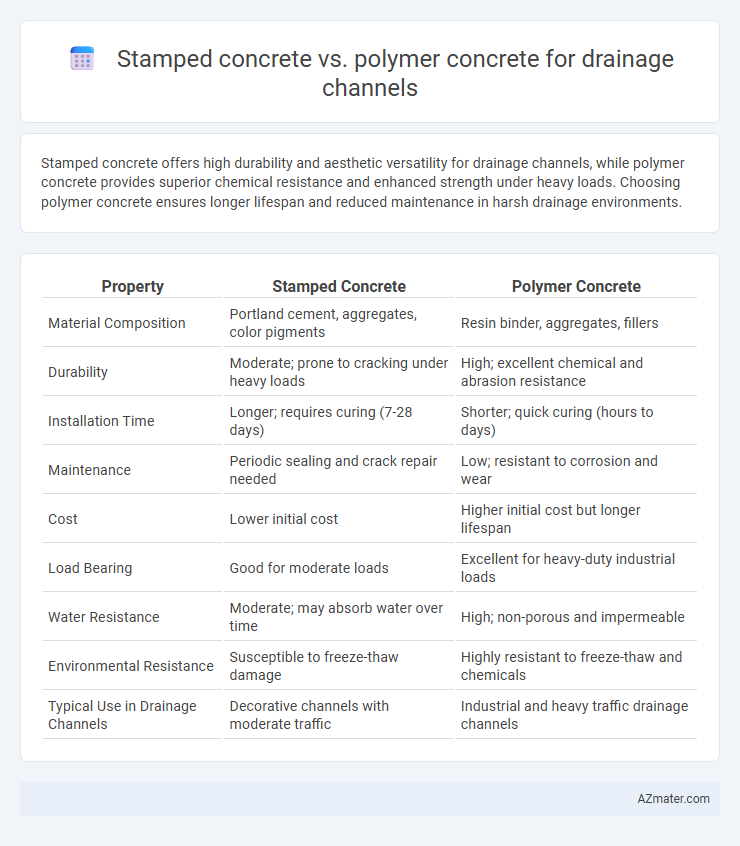Stamped concrete offers high durability and aesthetic versatility for drainage channels, while polymer concrete provides superior chemical resistance and enhanced strength under heavy loads. Choosing polymer concrete ensures longer lifespan and reduced maintenance in harsh drainage environments.
Table of Comparison
| Property | Stamped Concrete | Polymer Concrete |
|---|---|---|
| Material Composition | Portland cement, aggregates, color pigments | Resin binder, aggregates, fillers |
| Durability | Moderate; prone to cracking under heavy loads | High; excellent chemical and abrasion resistance |
| Installation Time | Longer; requires curing (7-28 days) | Shorter; quick curing (hours to days) |
| Maintenance | Periodic sealing and crack repair needed | Low; resistant to corrosion and wear |
| Cost | Lower initial cost | Higher initial cost but longer lifespan |
| Load Bearing | Good for moderate loads | Excellent for heavy-duty industrial loads |
| Water Resistance | Moderate; may absorb water over time | High; non-porous and impermeable |
| Environmental Resistance | Susceptible to freeze-thaw damage | Highly resistant to freeze-thaw and chemicals |
| Typical Use in Drainage Channels | Decorative channels with moderate traffic | Industrial and heavy traffic drainage channels |
Introduction to Drainage Channel Materials
Drainage channels require materials that combine durability, strength, and resistance to environmental factors. Stamped concrete offers aesthetic versatility and reasonable durability, making it suitable for pedestrian areas with moderate drainage needs. Polymer concrete provides superior chemical resistance, high compressive strength, and rapid curing, ideal for heavy-duty drainage channels exposed to harsh conditions and aggressive fluids.
What is Stamped Concrete?
Stamped concrete is a type of decorative concrete designed to mimic the appearance of natural materials like stone, brick, or wood by imprinting patterns and textures onto the surface before it fully sets. This method offers durable, aesthetically appealing solutions for drainage channels, combining functionality with a custom look. Its high compressive strength and resistance to wear make it suitable for managing water flow and preventing erosion in drainage applications.
Understanding Polymer Concrete
Polymer concrete consists of a mixture of aggregates bound with polymer resins, offering superior chemical resistance, durability, and rapid curing compared to stamped concrete. Its non-porous surface and high tensile strength make polymer concrete ideal for drainage channels subjected to aggressive chemicals and heavy loads. Unlike stamped concrete, polymer concrete provides enhanced longevity and minimal maintenance in industrial and municipal drainage applications.
Installation Process Comparison
Stamped concrete installation for drainage channels involves laying a concrete mix, followed by imprinting patterns and textures before the material fully cures, requiring skilled labor for accurate stamping and edging. Polymer concrete installation uses a resin binder combined with aggregates, allowing for faster curing times and easier mold casting, which can reduce labor costs and installation time in drainage applications. The choice between stamped and polymer concrete hinges on desired aesthetics versus speed and chemical resistance, with polymer concrete offering superior durability in harsh environments.
Durability and Longevity
Stamped concrete offers moderate durability for drainage channels but may develop surface wear and minor cracks over time due to exposure to heavy loads and weather conditions. Polymer concrete exhibits superior durability and longevity, resisting chemical corrosion, abrasion, and freeze-thaw cycles, making it ideal for harsh drainage environments. Its enhanced tensile strength and impermeability significantly reduce maintenance needs and extend the lifespan of drainage infrastructure.
Maintenance Requirements
Stamped concrete requires regular sealing to prevent surface wear and staining, with periodic cleaning to maintain its decorative finish. Polymer concrete exhibits superior chemical resistance and durability, reducing the frequency of maintenance and minimizing repairs in drainage channels exposed to harsh environments. Its low porosity makes polymer concrete less susceptible to cracking and erosion, ensuring longer-lasting performance with minimal upkeep compared to stamped concrete.
Aesthetic Options and Flexibility
Stamped concrete offers a wide range of aesthetic options, including customizable patterns and colors that mimic natural stone, brick, or wood, enhancing the visual appeal of drainage channels in both residential and commercial settings. Polymer concrete provides superior flexibility in design due to its ability to be cast into complex shapes with smooth finishes, making it ideal for functional drainage channels requiring precise geometries and durability. Both materials balance aesthetics and flexibility, but stamped concrete is preferred for decorative surfaces, while polymer concrete excels in structural adaptability and performance.
Performance in Harsh Environments
Stamped concrete offers aesthetic appeal but may develop cracks and surface wear under harsh environmental conditions like freeze-thaw cycles or chemical exposure. Polymer concrete exhibits superior performance in drainage channels due to its high chemical resistance, low permeability, and excellent durability against erosion and aggressive substances. Its enhanced mechanical strength and minimal maintenance requirements make polymer concrete a preferred choice for long-term resilience in demanding drainage applications.
Cost Analysis
Stamped concrete typically offers a lower initial cost compared to polymer concrete, making it a cost-effective choice for drainage channels in budget-sensitive projects. Polymer concrete, while more expensive upfront due to specialized materials and installation, provides superior durability and chemical resistance, potentially reducing long-term maintenance and replacement costs. Evaluating the total lifecycle cost highlights polymer concrete as a more economical option over time for high-traffic or chemically aggressive environments.
Which Material is Best for Drainage Channels?
Stamped concrete offers durability and aesthetic appeal, making it suitable for drainage channels in residential or decorative settings. Polymer concrete provides superior chemical resistance, higher tensile strength, and excellent durability under heavy loads, making it ideal for industrial and high-traffic drainage channels. For optimal performance in drainage channels exposed to harsh conditions and heavy use, polymer concrete is generally the best choice.

Infographic: Stamped concrete vs Polymer concrete for Drainage channel
 azmater.com
azmater.com